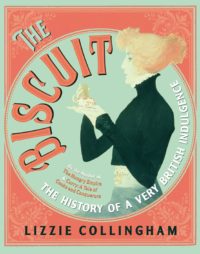Book review: The Biscuit: the History of a Very British Indulgence by Lizzie Collingham

I love a biscuit and I love well-written social history, so I was pretty keen to read The Biscuit: the History of a Very British Indulgence by Lizzie Collingham. It’s a fascinating book that had me frequently spouting interesting nuggets at anyone who happened to be around.
Collingham tracks the history of the biscuit from its Roman Empire beginnings as twice-baked bread, to being a culinary centrepiece for the super rich of the 17th century, to becoming a factory-made staple of every British household (and indeed much of the rest of the world). There are recipes dotted throughout, several of which I bookmarked.
The definition of biscuit is fairly wide here. In one chapter, Collingham explains how wafers and waffles can trace their origin to unleavened bread. In the first and second centuries CE, Jewish bakers began pouring unleavened batter into tongs to create thin wafers decorated with animals and flowers for Passover. Soon after, Christian bakers copied the idea but replaced the designs with their own religious imagery. As the practice spread of churches handing out wafers at Easter, over centuries they became a staple at bakeries, especially after sugar and spices spread to Europe and became part of the wafer recipes.
Another chapter is dedicated to biscuits as a digestive aid. When early sweet biscuits were introduced in Britain, they were considered stomach comforters. People would add caraway, coriander or aniseeds, all of which were believed to reduce flatulence and “balance humours”. The digestive biscuit is the culmination of centuries of recipes developed from there.
“In the same way that someone suffering from Pepys’ affliction today might reach for a Rennie tablet. A seventeenth century gentleman ate a biscuit. Sponge fingers had been introduced to England as ‘savrous’ confections that comforted the stomach. They contained sugar, that perfect foodstuff that helped the body maintain its natural equilibrium.”
The part of the history that I had been looking forward to was industrialization, the introduction of manufactured biscuits. That’s because one of the major early biscuit companies was Huntley & Palmers in Reading, where Tim and I went to university and where we met. We used to drink at a pub called Three Bs, named after the town’s three historic industries: bricks, beer and biscuits.
What I didn’t know was that the mass production of biscuits began with supplying food to the armed forces, especially the navy. For centuries, “ship’s biscuits” had been standard fare for sailors – effectively the same twice-baked bread that the Romans made for the same reason, namely that it can last for months. In the 19th century, the demands of the fast-growing British Navy led to a handful of steam-powered-machinery-filled warehouses taking over from hundreds of small-scale bakeries. Once they’d figured out the mechanisms, some of these same operations also started producing “fancy biscuits” for the general public. Who doesn’t love a fancy biscuit?
My one criticism is that Collingham repeatedly glosses over/euphemises colonialism and slavery. For a book written in 2020 to fail so badly to address how and why Britain was suddenly flooded with cheap sugar, for example, is honestly shocking. Even the chapter on how British manufacturers used the British Empire to expand their market, while a little more honest, evades the violence and white supremacy that are central to colonialism.
But I’m still going to try some of the recipes, and roll out my newly discovered biscuit facts whenever I get the chance.
Published 2020 by Bodley Head.
Source: Christmas present.
One Comments
Comments are closed.